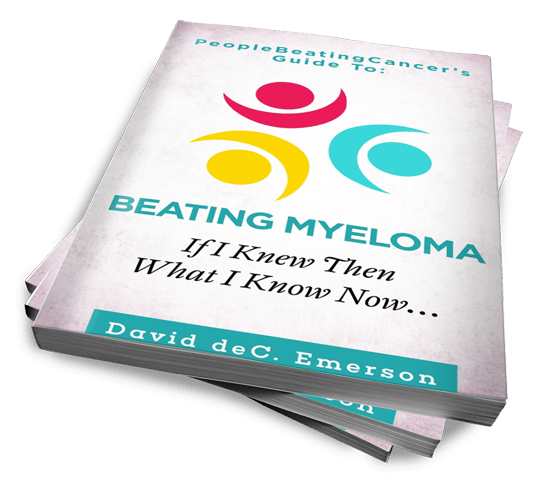Leave a Comment:
1 comment
[…] Evidence-based Oncology for Myeloma Patients? “Experimental?” “Off-Label?” […]
Reply
Learn about conventional, complementary, and integrative therapies.
Dealing with treatment side effects? Learn about evidence-based therapies to alleviate your symptoms.
Click the orange button to the right to learn more.

Multiple myeloma treatment, that is to say treating all mm patients, all with different symptoms, all with different stages of disease, is complicated. Oncology needs flexibility. Off-label use of a chemotherapy regimen simply means that the oncologist is prescribing the drug for a medical diagnosis that is different than what the FDA approved the drug for. Experimental use of a drug is using a drug or procedure that has not been approved by the FDA. For any medical condition.
In December of ’95 I underwent an autologus stem cell transplant as multiple myeloma treatment. Each of the various chemotherapy regimens that were administered had been approved by the FDA for something. However, an autologous stem cell transplant had not been approved for multiple myeloma by the FDA.
In 12/95, my ASCT was an experimental multiple myeloma treatment. My oncologist prescribed many chemotherapy drugs off-label.
In November of ’97 I underwent 17 months of antineoplaston therapy (ANP) as multiple myeloma treatment. This MM treatment was also experimental and my insurance company did NOT pay the cost of this MM treatment.
After 17 months of ANP therapy I achieved cancer-free status where I have remained ever since. Both therapies, the ASCT and ANP cost about the same- about $300,000.
My health insurance paid for my autologus stem cell transplant that put me in partial remission for 10 months and left me with short, long-term and late stage side effects. The same health insurance did not pay for antineoplaston therapy that cured my multiple myeloma and is non-toxic and left me with NO side effects, none.
This blog post is about the terms experimental and off-label and how these practices apply to multiple myeloma therapy. I just added the payment issues because I am still in disbelief about the payment issues…
I am both a MM survivor and MM coach. I’ve lived through both conventional and non-conventional multiple myeloma therapy and lived to write about them.
If you would like more information about experimental or non-conventional multiple myeloma therapy for your cancer, please scroll down the page, post a question or a comment and I will reply ASAP.
thank you,
David Emerson
In the United States, when the Food and Drug Administration (FDA) approves a chemotherapy drug it does so with a specific use, dose, type of cancer, stage, etc. in mind. Any board certified medical doctor can prescribe any FDA approved drug for any reason. Prescribing a drug for any use that was not FDA approved is referred to as “off-label.”
“Off-label use is the use of pharmaceutical drugs for an unapproved indication or in an unapproved age group, unapproved dosage, or unapproved form of administration.[1] Both prescription drugs and over-the-counter drugs (OTCs) can be used in off-label ways, although most study of off-label use centers on prescription drugs. Off-label use is generally legal unless it violates specific ethical guidelines or safety regulations, but it does carry health risks and differences in legal liability.”
What does the term “evidence-based” mean when talking about chemotherapy?
“Evidence-based medicine (EBM) (also called evidence-based health care (EBHC) or evidence-based practice (EBP) to broaden its application from medicine to the allied health professions) is “the conscientious, explicit and judicious use of current best evidence in making decisions about the care of individual patients…”
Does Off-Label Chemo Drive Up Healthcare Costs?
“Today I want to discuss an interesting study[1] that has attempted to quantify the use of off-label chemotherapy in the United States…
These investigators used a national prescribing database to collect information on 10 patented chemotherapy drugs. All of these drugs were given by intravenous injection or infusion. The database was generated from a range of 122 oncology practices, employing 570 oncologists in 35 states in the United States. The audit was undertaken in 2010 and involved 19,500 patients. The authors then used the costs of drugs in the sample set. They analyzed the total drug sales and used that to extrapolate a national figure…”
Study Results: Significant Percentage of Off-Label Treatment
“The analysis found that 70% of drugs given intravenously were, according to the US Food and Drug Administration (FDA), approved by disease, by disease stage, and by line of therapy. Thus, 30% would be off-label using FDA criteria…
Thirty percent of chemotherapy is given off-label. This is better than some past estimates which have been significantly higher, but if we look at this and consider, along with the attendant costs of delivery, physician time, nurse time, managing side effects, hospital admissions and so on, this would add up to a significant health burden. In looking at drugs alone, the off-label cost of drugs was $4.5 billion. One imagines that cost would be multiplied significantly when we add these other costs…
Chemotherapy often costs thousands of dollars per month and if it works, it will buy that patient months not years. Months of side effects as well. The question for cancer patients and survivors is whether or not chemo- FDA approved, on-label, off-label, whatever, is curative or is palliative. In short, ask your onc what the expected result is of the therapy that he/she is prescribing for you.”
“Purpose The prevalence of off-label anticancer drug use is not well characterized. The extent of off-label use is a policy concern because the clinical benefits of such use to patients may not outweigh costs or adverse health outcomes.”
[…] Evidence-based Oncology for Myeloma Patients? “Experimental?” “Off-Label?” […]
Reply